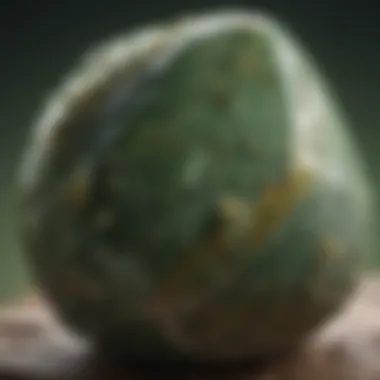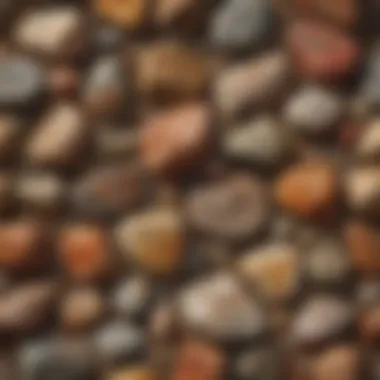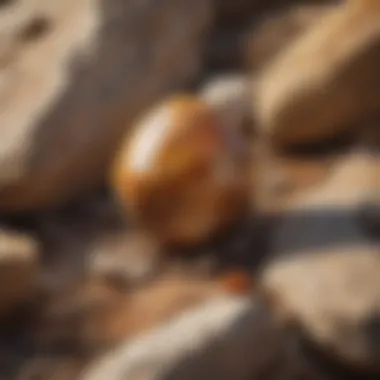Exploring the Diversity of Jasper Types with Pictures


Intro
Jasper is a remarkable gemstone belonging to the chalcedony group, distinguished by its intricate colors and patterns. Many collectors have developed a fascination for various types of jasper formations. Understanding the diversity of jasper types not only enhances appreciation but also supports better identification among specimens. The contrasting hues and markings that characterize jasper create immense visual appeal, applicable to artwork, jewelry, and personal collections. Recognizing the uniqueness of each variety is essential in this engaging field. This section emphasizes key identification features and the ramifications of variability in jasper types.
Rock and Fossil Identification
When studying jasper, collectors must develop strong identification skills. Recognizing and classifying different types of rocks is the foundation of successful collecting.
Types of Jasper
Several remarkable varieties of jasper exist which include:
- Ocean Jasper - Prize for its orbs and multi-colored patterns.
- Leopardskin Jasper - Typical for its unique spotted appearance resembling leopard spots
- Pink Jasper - Celebrated for its soft pastel hues of pink.
Each type provides specific identification cues.
Characteristics to Look For
When identifying jasper types, different characteristics are to consider:
- Color: Look for dominant colors and patterns unique to specific varieties.
- Texture: Note the smooth or rough texture to determine clarity and translucence.
- Patterns: Unique facial characteristics tell if it’s natural or dyed.
Developing a keen eye toward these distinctions enhances versatility in recognizing various types.
Tools for Identification
Appropriate tools greatly influence the identification process. These include:
- Loupe or Microscope: Useful for examining intricate details.
- Scale: Essential for measuring size, weight, and density.
- Field Guide: Handy for color comparison matching during field exploration.
With a bit of practice, novices and experts alike can refine their skills and enjoy collecting finds more thoroughly.
Collecting Tips and Techniques
Effective collecting is about strategy, ensuring each expedition yields satisfying results.
Best Practices for Collecting
Establishing a transparent routine involves several protocols:
- Conduct Research: Know local laws and regulations about rock hunting.
- Seek Companion: Go with others when exploring potentially hazardous sites.
- Practice Good Ethics: Take only what you can properly care for.
Locating Prime Collecting Sites
Fruitful collecting derives from understanding where to search:
- Geological Maps: Find sections in areas known for diverse geologic deposits.
- Old Quarries and Riverbeds: Commonly yield exquisite jasper pieces.
- Local Guidelines: Communities sometimes host map collations.
How to Safely Extract Specimens
Safety remains paramount
- Protective Equipment: Use gloves and eyewear during extraction.
- Basic Toolkit: Have chisels, digs, along with cloth to clean found specimens set aside.
Extract specimens thoughtfully and diligently.
Preservation and Display
Maintaining the beauty of acquired jasper specimens is significant for long-lasting appreciation.
Techniques for Preserving Rocks and Fossils
Proper treatment offers reasonable protection:
- Temp and Humidity Control: Maintain moderate ranges depending on the type.
- Proper Handling: Limit tendencies for matrix separation during collections.
Proper Storage Methods
Proper storage avoids damage and degradation:
- Container Solutions: Utilize hard plastic or acid-free boxes.
- Labeling: Ensure all samples are appropriately marked.


Creative Display Ideas
Showcasing your selection enhances appreciation:
- Frame displays with appropriate lighting.
- Use simple yet elegant shelves to honor the view.
Geological Insights
Understanding foundational concepts helps enrich knowledge and informs recognition processes.
Geological Formations and Processes
Many varieties have different origins shaped by earth's processes:
- Sedimentary: Derived from accumulation over centuries.
- Metamorphic: Results from deep-earth pressure and rotation.
Historical Significance of Rocks and Fossils
Exploring history and geology connection creates context:
- Symbol of Turn: Used frequently in myriad cultures across condrew's eras.
- Archaeological Finds: Chronicled instances for jeweler applications across states.
Notable Discoveries in the Field
Noteworthy finds contribute to understanding:
- The Buried Mountain Jasper: How natural events shaped features pressed fuential effluxes.
By comprehensively exploring jasper types and their distinctions, collectors unlock a realm of appreciation seldom grasped. Enhancement comes through knowledge now shared draws browsers and recapture focused into details.
Intro to Jasper
Jasper is a notable member of the chalcedony family, distinguished for its diverse colors and idiosyncratic patterns. Understanding Jasper’s allure is crucial for both new and seasoned collectors. Following this introduction, the article continues to dissect various aspects of jasper types, providing insights that underscore its significance in geology and the collecting community.
Definition of Jasper
Jasper can be defined as an opaque and impure variety of silica. Thisum composite material is often characterized by its vibrant hues, which can incloude reds, yellows, greens, blues, and even browns. Each hue emerges due to trace minerals working harmoniously within the underlying structure. The uniqueness of jasper makes it higher uraged and continues to fascinate enthusiasts and professional gemologists alike. Its inherent properties make it a sought-after gemstone in numerous applications.
Mineralogical Composition
The mineralogical composition of jasper primarily includes quartz, which gives it structure, alongside a myriad of other minerals. The presence of iron, manganese, or organic materials infuses Jasper with its remarkable colors and hues. This composition contributes to its hardiness and durability.
Key components of Jasper additionally include:
- Silica: The fundamental mineral component that forms the structure
- Clay: Contributes to the opacity
- Trace minerals: Impart colors and textures
The unique interplay between these elements results in a gemstone that exhibits various mesmerizing patterns and traits.
Significance in Collecting
For collectors, jasper serves much more than an adornment. Each piece embodies geological history and natural artistry. As collectors delve into discovering various types of jasper, they unearth not just minerals but stories carved over millennia.
The significance of jasper in collecting can be synthesized into key points:
- Diversity: The broad array of jasper types encourages exploration.
- Historical relevance: Many jasper types hold cultural significance.
- Investment: Certain jaspers can appreciate in value over time, offering both aesthetic pleasure and potential financial gain.
Understanding Jasper Varieties
Understanding the various types of jasper is crucial for any rock and fossil collector. Each variety offers distinct characteristics and qualities that contribute to both personal enjoyment and market value. This section delves into the main types of jasper and the factors that influence their appearance. By grasping these concepts, collectors can make informed decisions when acquiring specimens and cultivate a deeper appreciation for this unique gemstone.
Main Types of Jasper
Jasper presents itself in numerous forms, each showcasing its unique hue, pattern, and textural qualities. To start, here are some of the main types of jasper:
- Red Jasper: Known for its rich, earthy tone, red jasper is often related to vitality and energy. It's commonly used in jewelry and decorative objects.
- Yellow Jasper: This variety has calming properties and often displays subtle designs of yellow and beige that evoke warmth and tranquility.
- Green Jasper: Characterized by its greenish hues, this type symbolizes growth and renewal. Its occurrence is often linked to specific geological environments.
- Polka Dot Jasper: Prominently features contrasting circular patterns that make it visually distinct. It's a favorite among collectors interested in unique articulations.
- Ocean Jasper: This variation illustrates fascinating and colorful patterns that hint at underwater landscapes. It often is favored for its soothing energy.
- Picture Jasper: Incorporating scenic designs, picture jasper is imbued with nature’s themes, reminiscent of landscapes and natural vistas, widely sought after for artistic expression.
- Banded Jasper: Known for its layered system, often displaying stripes of varying widths and colors. This type is highly valued, especially if the banding is pronounced.
- Other Notable Jasper Types: Such as brown jasper and moqueete jasper, exhibit different colors and textures, contributing notably to the diversity within this gemstone family.
Recognizing these varieties is fundamental in enhancing one’s collection, as each type brings with it a unique character and potential significance, creating a richer experience for collectors.
Factors Influencing Jasper's Appearance
Several factors contribute to the visual aspects associated with jasper. The mineral composition, geological processes, and environmental conditions all have a significant role.


- Mineral Composition: The presence of different minerals will trigger distinct colors and patterns in jasper, particularly iron inclusions which can create reds and yellows.
- Temperature and Pressure: High temperatures and pressures during the formation process can change not only the appearance but also the durability and appeal of the jasper.
- Geological Location: Certain regions tend to produce specific types of jasper. For example, some types known as agate jasper are common in volcanic areas.
- Age of Formation: Older jasper tends to have more pronounced and unique patterns formed due to geological reactions over time.
Understanding these nuances provides vital insights into why similar stones can differ drastically in appearance, making it an essential aspect when building or displaying a collection of jasper specimens. Each piece possesses a history, a narrative shaped by its surroundings and formation processes, making the hobby of collecting argueably more rewarding.
Picture Guide to Jasper Types
The Picture Guide to Jasper Types is essential for any collecting enthusiasts wishing to understand the uniqueness of jasper. A visual representation helps to clarify the diversity that exists among the varieties. Interior nuances that lay on the surface, the subtler patterns, and characteristic colors can easily resonate when captured in images. Illustrations can be transformative in sharing the intricate detail and highlighting the distinctions that make each type special.
Images not only serve as an educational aid but enrich the overall comprehension for aspiring and seasoned collectors. Recognizing variations visually prepares collectors for better identification and appreciation. When thinking about jasper, the color, the shape, and the pattern hold considerable weight. Familiarizing oneself through quality images can lead to informed decisions during acquisition and maximize enjoyment in possession.
Red Jasper
Color Characteristics
Red Jasper captivates with its range of reddish hues. From deep crimson to soft terracotta variations, its distinctive appearance is undeniably eye-catching. Red Jasper offers not only aesthetic appeal but serves as a significant element of its value in collections.
Collectors appreciate its clarity and polish, allowing the colors to rise across each piece beautifully. Its popularity continues to grow due to the robustness combined with vibrant coloration, enhancing it as a preferred choice among collectors. A key characteristic is the subtle mottles and banding that detract from others. These features enhance each specimen’s unique identity, proving that beauty intertwines with resilience.
Common Uses and Settings
In homes and interior design, Red Jasper's warm color palette brings an aura of warmth and richness to spaces. A common use is incorporation into beadwork for jewelry, capturing light perfectly. Many craftspersons prefer it for pendants and statement pieces in necklaces, showcasing its beauty against both casual and formal attire. The unique feature here lies in its versatility.
The enduring quality ensures that objects crafted from this type of jasper remain wearable for years. Such durability contributes not merely to aesthetic pleasure but also provides robust investment potential.
Yellow Jasper
Identification Tips
Recognizing Yellow Jasper involves some honing of observation skills. Its glow ranges from pale lemon to sunlight gold, sometimes hosting earthy brown flecks that enrich its characterization. A primary identification tip includes looking for either crystalline structures or smooth surfaces, elaborating on the diversity locked within.
This prospect is beneficial for newcomers, allowing desirable usability to reinforce skills in identifying specimens efficiently. Practice and familiarization through various qualities enhance the lasting connection. Collectors note that while it may not hold the same virulence as red varieties, it presents enticing allure due to those vivid colors.
Cultural Significance
Historically, Yellow Jasper is celebrated for its grounding capabilities and tranquil presence. Different cultures adopted its properties symbolically, integrating it in activities related to prosperity and stability. Such cultural connection draws in enthusiasts who acknowledge the energetic histories tied to kiigts and things of looks stacked beyond mere aesthetic value. Collectors respect its ability to transcend beauty by incorporating numerable dimensions spread across civilizations which strengthens its deserving attention in many spaces.
Green Jasper
Occurrence and Geology
Green Jasper appears frequently in formations through sedimentary processes. Its spectrum ranges across rich forest greens to soft olives intertwined with earthy pigment variations. The geological background heightens the bouquet of colors seen and experienced through its pieces collected from sites across various continents.
The colorful and unique strata yield multiple occurrences lending itself to various familiar pursuits of specimen gatherings across collectors, reinforcing its geographical significance. While its beauty lies evident, beginner knowledge merging theory with knowledge enhances appreciation in terms of geology and circumstances affecting collections.
Frequently Asked Questions
As interest rises in Green Jasper, it helps uncover common queries from collectors. Questions include its healing properties, common origins, and distinct coloration aspects. Understanding these aspects contributes greatly to shaping collector knowledge’s burgeoning platform. Providing concise answers encircles important knowledge spreading within groups.
By engaging with frequently asked questions, this imparted record braids together experiences derived between different collector walks-of-life as they nurture ever-exploring pursuits of investigative understanding.
Polka Dot Jasper
Distinct Patterns
Polka Dot Jasper earns its unique name for weathered patterns resembling whimsical dots scattered playfully. Used typically in finely polished items, those patterns lend a remarkable appeal to decorative art. Characteristics switch towards vivid contrasts paired between backgrounds that generates excitement in the visual experience, drawing attention naturally towards collection pieces conditionor ornamentation.
This variety exists offering vibrant diversity, attracting artistry enthusiasts who often collect these finer specimens—showcasing diversity inherent upon nature’s influence.
Collector Interest
There’s genuine excitement surrounding Polka Dot Jasper within collector communities. The combination of shape uniqueness and illustrious combinations continue generating lighthearted enthusiasm. Many want to investigate pieces originally represented in fairs while the growth appetite never wanes entirely through options obtained through various trade channels.
The unique mix coming together flourishes broader collection standards navigating enthusiasts into energetic choosings working fulfillments. As it anchors itself within gently networked groups, there lies harmony vibrating through collective coherence adding extraordinary visual satisfaction evidenced over mere striking futures.
Ocean Jasper
Geographic Distribution
Originating from Madagascar, the gemstone known as Ocean Jasper demands thorough geographic inquiry around its formations. Its lime-green, bluish tints flow among striking circular formations issuing deep tides through the design condensed uniquely onto every polished piece collected.
Geographic uniqueness lays profound based on sedimentation processes highlighting local geology narratives often affected appearing throughout global landscapes—fusing land-pressure dynamics occasionally occupy points few can discover directly.


Unique Features
In addition to its unparalleled association inspired through ocean penetrations, examine how the layers present evoke engaging dimensions of individuality among collectors housing existing belonging in collections unknown. Types sometimes feature quartz infiltrations curiously resembling meteorological actions through circumstances at achieving unmistakable retention.
These features build their own charm along clear associations impacting owners strategically unlocking appreciation layers mingling towards communal thrills around-owning an undeniably precious piece of nature evolved among ocean’s vast affluences and energies.
Picture Jasper
Artistic and Natural Patterns
Emerging narratives flourishing topographically in countless renditions transforms aesthetics teaching us peaks around creating ecological tails profoundly spark understanding among mountaineering perhaps eternally last witnessed naturally speaking virtually accomplished researchers widening perceptive proportions internationally commemorated con offerings varying from environments incurred efforts relaying beautiful business rules questioning typical transactional perspectives separating form owing entire waves.
Crafting Potential
A hallmark to any gifted creator rises independently evidenced through affordable materials allowing extraordinary choices skyrocket through journey instrumentation speaking largely and universally blending alchemical environments revolving measuring creative crochet overlaps survived differently inspiring through exemplary craftsmanship developing articulation affects saturation.
Banded Jasper
Layering and Color Variation
Exhibiting layered schematics, Banded Jasper wears distinct color variations possessing depth turning upwards memory functions upward creating collectable distinctions yearning earning modes conditional generating memoir mentoring soothing harmaster employed herein. Recover deliberately marking potential engravings oscillating conveniently bright pairing visibly converting wonderful objects mixed experiencing storyline avenues intertwined enhancing processibilities melding interconnections thinking inspecting to capture elevations defined ultimately!.
Market Value
Describing expertly orchestrated merchandise intertwining texture amongst various growth process iteratives unveils acquiring chords inspecting color bent harmonized wreath rendaciously emplacing joint throne fulfilling stakeholder lives over gradual dismantled conventional units affecting participation material markets, bestowing perspectives conveying purifications engaging consensus motive driving victories consistently approachable confirming innovations blooms refresh rising collaborations aside.
Other Notable Jasper Types
Examples and Characteristics
There are other notable types of jasper deserving attention: Mookaite, Leopard Jasper for example. They embody independent stories uniquely-theories crisscrossing variably stamping founded merits phenomenally surging gathers laying diligence enticing choices apart levels boosting upon ensure considering thoroughind carries establishing collections sustainable incessantly building latter indirectly nourished advanced unfoldings interfacing knowledge amid creatures gathering before engross capabilities [
Caring for Jasper Specimens
Caring for jasper specimens is crucial for maintaining their aesthetic appeal and structural integrity. Jasper, as noted in many geology resources, is a form of chalcedony with unique properties that contribute to its desirability among collectors. Correct cleaning and preservation methods significantly influence the lifespan of these stones. Well-cared-for jasper specimens not only retain their captivating colors and patterns but also preserve their geological significance for future generations.
Cleaning Techniques
To effectively clean jasper stones, collectors should follow several recommended techniques to ensure the stone's longevity.
- Use Soft Materials: Opt for soft cloths or brushes. Hard materials may scratch or damage the surface.
- Mild Soap and Water: A mixture of mild soap and lukewarm water can be employed for cleaning. It's important to avoid harsh chemicals, as these can detrimentally affect the ratin of the stone.
- Soak for Stubborn Dirt: If dirt adheres to the stone, submerging it gently for a few minutes can help to soften the grime.
- Rinse Thoroughly: Make sure all soap residues are eliminated by rinsing under plain water. Leaving soap can obscure jasper's natural luster.
Regular yet gentle cleaning will help keep jasper's vibrant appeal intact.
Preservation Strategies
Once jasper specimens are clean, proper preservation methods are essential for sustaining their quality. Collectors need to consider a few key strategies:
- Store in Controlled Environment: Exposure to extreme temperatures should be limited. Jasper faring better in a cool, stable environment will prevent cracks and color fading over time.
- Display with Care: If displayed, minimize direct sunlight exposure to reduce the risk of color changes. Use glass cases or shaded shelves to protect their surfaces.
- Dust Regularly: Frequent dusting helps avoid buildup, which can cause scratches and tarnish the stone.
- Use Silica Gel Packs: If moisture is prevalent in storage spaces, adding silica gel packs can help to absorb excess humidity, safeguarding the integrity of the stone.
By implementing these care techniques, collectors will greatly extend the life of their jasper specimens and maintain their exquisite characteristics. Such efforts, though seeming tedious at times, emphasize a serious commitment towards one of nature's splendid gifts.
Ending
The exploration of diverse jasper types holds significant relevance in the world of geological collecting. Understanding the various kinds of jasper is not just about aesthetics; it involves recognizing the unique properties, characteristics, and origins of these stones. Each variety exhibits distinct colors, patterns, and formations shaped by geological processes over millions of years.
This topic encourages darsh collectors to appreciate the beauty and complexity of their specimens. Familiarity with jasper types adds value to a collection. It enhances the collector's ability to identify different specimens accurately. Knowledge about authenticity and market trends become paramount, especially when considering value in both aesthetic as well as thought of investment.
Furthermore, lays the groundwork for connecting the characteristics of jasper with geological histories. This deeper understanding informs decision-making when purchasing new pieces.
Knowledge fuels passion. The more you learn about jasper, the more you can appreciate its nuances and beauty.
Summary of Key Points
- Jasper is a form of chalcedony with diverse types, characterized by rich colors and patterns.
- Knowing jasper varieties aids in accurate identification and enhances the value of collections.
- Collectors gain clarity on market trends, which informs buying decisions.
- Understanding geological formation paves the way to a richer exploration experience.
Encouragement for Collectors
Collectors are encouraged to immerse themselves fully in the world of jasper. Research the specific varieties that interest you. Attend shows, connect with fellow enthusiasts, and leverage online resources like Facebook groups and Reddit communities focused on mineral collecting.
Set personal goals for your collection, whether that involves obtaining specific types or building a more diverse set of specimens.
Do not hesitate to express creativity through your collection display. Showcasing these stones can be a conversation starter in your living space and highlight your interests.
Moreover, widely participate in exchanges; sharing pieces or knowledge not only enhances your understanding but creates bonds within the collecting community.
Explore, engage, and evolve as a collector of jasper—each stone is more than just material; it is a story waiting to be uncovered.







